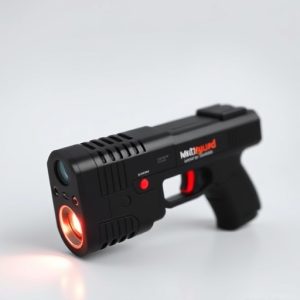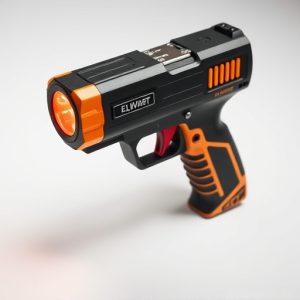Mastering the Multiguard Stun Gun: A Guide to Safe and Legal Self-Defense Use
When it comes to personal safety, a self-defense weapon can be a deterrent against potential threat…….
When it comes to personal safety, a self-defense weapon can be a deterrent against potential threats. Among the array of options available, the Multiguard Stun Gun stands out as a reliable choice for many individuals seeking protection. This article delves into the essential aspects of the Multiguard Stun Gun, from its innovative features and advanced technologies to the legal framework governing its use. We’ll guide you through understanding what makes this stun gun a preferred self-defense tool, the key elements that set it apart, and the practical tips for employing it effectively in self-defense scenarios. Whether you’re considering the Multiguard Stun Gun as a means of protection or are an existing user looking to enhance your skills, this comprehensive guide will equip you with the knowledge necessary to navigate its use responsibly and confidently.
Understanding the Multiguard Stun Gun: A Comprehensive Guide
The Multiguard Stun Gun is a self-defense tool designed to provide individuals with a non-lethal means to protect themselves against potential threats. Understanding its components, functionality, and legal implications is crucial for effective use. This guide aims to demystify the operation and applications of the Multiguard Stun Gun, ensuring users are well-informed about this self-defense device.
The Multiguard Stun Gun operates on a high-voltage electric charge that is delivered through two electrodes. When activated, it can incapacitate an attacker by causing muscle contractions and disorientation without inflicting permanent injury. Its visible safety features and distinct design help prevent accidental activations. Additionally, the Multiguard Stun Gun often comes with a flashlight feature, combining personal protection with a practical illumination tool. Users should familiarize themselves with the proper deployment techniques, understanding that the effectiveness of the stun gun relies on correct positioning and aim. It’s also essential to be aware of local laws concerning the use of stun guns for self-defense, as regulations may vary by region. This guide will delve into the specifications, safety considerations, and best practices for utilizing the Multiguard Stun Gun effectively in various self-defense scenarios.
Key Features and Technologies of the Multiguard Stun Gun
The Multiguard Stun Gun is a self-defense tool engineered with advanced features and technologies tailored for personal safety. At its core, this device delivers a high-voltage electric shock to incapacitate an attacker, providing a significant non-lethal deterrent. One of its standout features is the built-in LED flashlight that operates independently of the stun function, ensuring users have a reliable light source for disorienting assailants or for use in low-light conditions. The ergonomic design ensures a firm grip, which is crucial during high-stress encounters. The Multiguard Stun Gun also incorporates a safety feature that prevents accidental discharge, enhancing its user-friendliness and reliability. Its rechargeable battery not only conserves the environment by eliminating disposable batteries but also ensures consistent performance when needed most. Additionally, the device features multiple voltage settings to address different threat levels, allowing users to select the most appropriate level of defense based on the situation at hand. The Multiguard Stun Gun is designed with a concealed design for discreet carry, making it an ideal companion for individuals who prioritize personal safety without overt display of self-defense tools. Advanced electroplating technology ensures the device’s durability and longevity, while its compact size belies the powerful defense mechanism it harbors. Users can rely on the Multiguard Stun Gun as a dependable self-defense weapon, equipped with features that cater to their safety needs in various scenarios.
Legal Considerations When Carrying a Multiguard Stun Gun
When considering the use of a MultGuard Stun Gun for self-defense, it is imperative to be aware of the legal framework governing its possession and use. The legality of carrying a stun gun varies by state and local jurisdiction within the United States; therefore, potential owners must familiarize themselves with the specific laws in their region. In some areas, stun guns are classified as concealed carry weapons and require a permit or license that may involve background checks, safety training, and adherence to certain conditions of use. It is crucial to understand that the legal status can be influenced by factors such as the capacity of the stun gun, its voltage, and even the manner in which it is carried or displayed.
Moreover, individuals must stay informed about any changes in legislation that could affect their rights to own and carry a MultGuard Stun Gun. This includes not only new laws but also the interpretation and enforcement practices of local law enforcement. Users should also be aware of the circumstances under which they are legally justified in deploying the stun gun for self-defense. Self-defense laws vary, and the effectiveness of a stun gun as a deterrent is dependent on the situational context. Prospective owners must ensure they are well-versed in these legal considerations to responsibly carry and use a MultGuard Stun Gun within the confines of the law. Understanding the legal implications mitigates the risk of unintended legal consequences and ensures that the stun gun remains a tool for personal safety rather than a source of legal complications.
Practical Tips for Using Your Multiguard Stun Gun Effectively in Self-Defense Situations
When utilizing a Multiguard Stun Gun for self-defense, it’s crucial to familiarize yourself with its features and limitations. The effectiveness of this device is significantly influenced by your proficiency in handling it under pressure. Firstly, always keep your stun gun charged; a depleted battery could leave you vulnerable when you need it most. Practice deploying the device quickly from its carrying case, as time can be a critical factor during an encounter. Understanding the stun gun’s configuration, such as locating the power switch and electrode probes, will help you respond more decisively.
In self-defense scenarios, aiming the Multiguard Stun Gun is pivotal for its incapacitating effects. The goal is to deliver a shock to an attacker’s larger muscle groups, such as the torso, arms, or legs, rather than sensitive areas that could harm them unnecessarily. Maintain contact with the assailant for the duration of the discharge to ensure the current continues to flow. Additionally, practice scenarios in safe environments to gain confidence and improve your response time. Remember to follow local laws and regulations regarding self-defense weapons; understanding these can prevent legal complications post-incident. Regular training with your Multiguard Stun Gun will enhance your ability to use it effectively should you ever find yourself in a self-defense situation.


